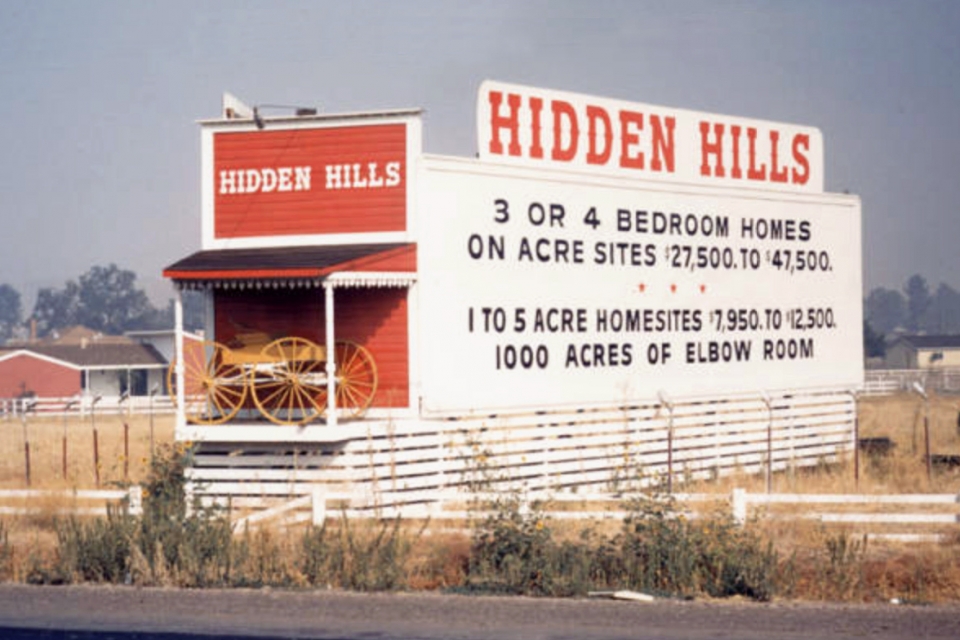Two oak trees on a long dirt road with the rolling hills alongside. This was all one would see early in 1950 when A.E. Hanson (who also developed the community of Rolling Hills on the Palos Verdes peninsula) began his development of Hidden Hills.
In 1950, a large sign on Ventura Boulevard at Long Valley Road announced:

The “1000 acres” were composed of the following purchases: 1) in 1949, 700 acres acquired from E.E. Hurlbutt; 2) in 1950, 160 acres purchased from Nace, et al; 20 acres from Mrs. Lasher; 119 acres from the Straubinger family; and 5.6 acres from Spinks — a total of 1004.6 acres.
Two model homes were built in 1950 — 23704 Long Valley Road and 23629 Long Valley Road. The latter was the first house purchased. Leo Gorcy, one of the Dead End Kids of movie fame, bought it for $35,000.
Ever wonder where the street names came from? Long Valley and Round Meadow because that’s what they looked like — a long valley that turned into a round meadow. Lasher Road was named because the Lasher home was on that road. One field was covered with 6-foot-high mustard and was a gathering place for red-winged blackbirds, thus Wingfield Road. According to A.E. Hanson, his children read books about early Western American explorers and trappers, so the roads in the Round Meadow area were named for these trailblazers, in hopes that future generations of children in Hidden Hills would become interested in the history of the American West from 1805 to 1830.
Lamond Chamberlain became the second major developer of Hidden Hills in 1956. A.E. Hanson turned over his declarant’s rights and his fee ownership of certain properties to the Hidden Hills Community Association, including the pool property on Long Valley, the bus stop property at Jed Smith and Round Meadow, Long Valley Road itself and the front gate house. He then sold his undeveloped land to Hidden Hills Estates Inc., with Lamond Chamberlain being the president and Ruby Chamberlain the secretary.
By 1957, the cost of a three or four bedroom home on a 1 acre site was $27,500 to $47,500. One to 5 acre home sites were selling for $7,950 to $12,500.
In October of 1958, Alice Stelle and Eleanor DeCarteret started a monthly newspaper, the “Las Virgenes Enterprise.” In 1963, it started weekly publication. Alice and Eleanor later sold the paper, but it is still published today.
In the summer of 1959, 6-year-old Deborah Williams said, “Wouldn’t it be fun if we could sit on our ponies and horses for church?” and thus originated the “Church on Horseback.” It was truly an outdoor devotional worship service and was a wonderful experience for those of all ages who loved the great outdoors and horses. Families arrived not only on ponies and horses, but also on donkeys, in buggies, and in surreys — yes, with the fringe on top.
In the spring of 1961, civic leaders in the tiny community of Hidden Hills launched a drive to form a city. They were faced with the prospect of being annexed to the City of Los Angeles and having Burbank Boulevard extended through the community. The petition for cityhood was signed by 79% of the voters, and despite the fact that the Los Angeles City Council’s Planning Committee opposed the incorporation, it was approved by the Board of Supervisors. September 19, 1961, was designated as election day, when a total of 358 votes were cast for incorporation (83% of registered voters), with 71 votes against. The area of the new city was approximately 1.3 square miles, with a population of a little over 1,000 and an assessed valuation of $2,681,910. On October 19, 1961, Hidden Hills became the 73rd city in the County.
On election day, the voters also elected their first five Council Members from 13 candidates: attorney John R. Hansen Jr. (284 votes); products distributor George E. Hartstone (251 votes), who became the first Mayor; electronics foreman Louis K. Knue (207 votes); physicist William A. Snyder (197 votes); and engineer Robert C. Malneritch (194 votes).
On August 21, 1962, the Hidden Hills City Council adopted its first budget of $18,088 at its first meeting in the Administration Building at the Hidden Hills Swim Club at 24549 Long Valley Road. Previously, the first City Clerk, Eileen Henry, had an office at the Hidden Hills Mutual Water Co. in Calabasas and Council meetings were held in Mayor George Hartstone’s living room. The main expenditure of this first budget was $13,125 for the L.A. County Sheriff, with a total of $3,000 for the salaries of the City Clerk and City Attorney, both of whom were part-time employees. Income sources included $8,500 from the State for “in lieu” taxes; $8,000 in property taxes; $1,000 from building permits; and $250 from the Calabasas Justice Court fines and forfeitures.
The first Fiesta was held October 20, 1962, to celebrate the first anniversary of the City’s incorporation on October 19, 1961. Monte Montana Jr. was the first Grand Marshal of the parade that started at noon on Long Valley at Oakfield. Other activities included a horse show, with a roping exhibition by Monte Montana; a barbecue dinner; and a teen dance and entertainment, recruited from local talent. The annual Fiesta celebration has continued over the years, growing into a huge party and gathering of neighbors honoring the birth of this unique little city.


